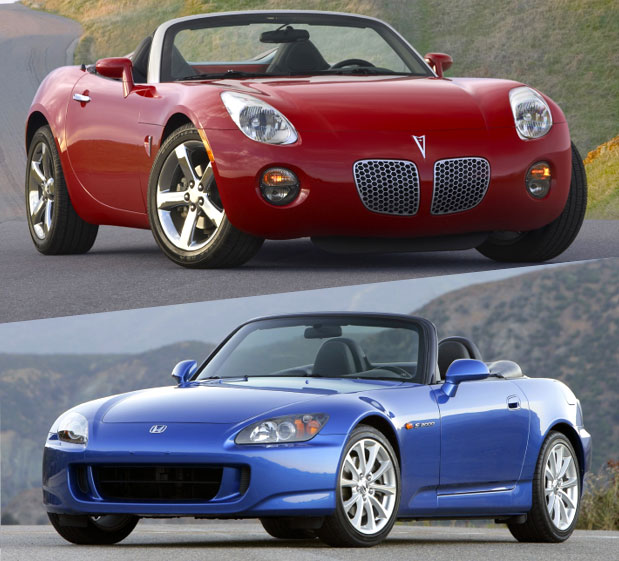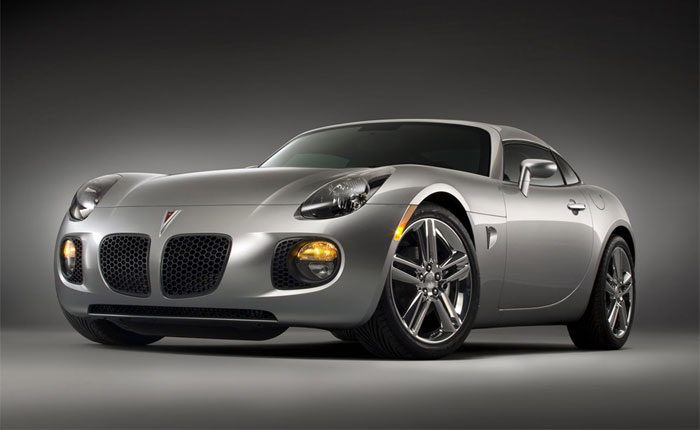Electric vehicles only accounted for 1.9% of new vehicle sales in 2019, down from an all-time high of just 2.1% the year prior. This was all in spite of an influx of new zero-emission vehicles hitting the market year-over-year. The EV market’s extremely limited reach hasn’t detoured General Motors from investing $20 billion in the technology in an attempt to supplant Tesla as the market’s go-to supplier of zero-emission vehicles.
Regardless of anyone’s feelings about this investment from a business perspective, it is hard to argue against the state-of-the-art flexible BEV3 Platform that materialized from the venture. In fact, it is so impressive that Honda is now on board to jointly produce plug-in electrics on the new chassis.
The news of these two industry stalwarts cooperating inspired a great deal of thought around the (home) office about what other fruits this new international partnership could yield.
A few ideas were thrown around, “How about a resurrected Avalanche and a beefed-up next-generation Ridgeline?” “An Element/Pontiac Aztek mashup just might be fun and funky enough to sell today.”
That was it… Pontiac! For the first time in its existence, the Aztek caused a eureka moment! If GM and Honda are going to focus their union on low-volume cars, the best way to do it would be by teaming up on a small roadster revival. What the EV deal needs is a small expansion that includes a pair of co-developed sub-3,000-pound roadsters that can pick up where the Honda S2000 and Pontiac Solstice left off just over a decade ago.
Quick History Lesson

The S2000 and Solstice were both small, rear-wheel-drive roadsters that were canceled in 2009 (though 30 examples of the Solstice and its platform mates did make it out of the plant with 2010 VINs, but that is a story for another time). Both of them were powered by engines that either hold or once held specific output records. The high-performance GXP version of the Solstice was powered by a dual-scroll turbocharged 2.0L Ecotec inline-four that made 260 horsepower and an equal amount of torque. At 2.1 horses for each of its 121.9 cubic inches, the GXP has the highest specific output of any General Motors product in history (for comparison, the monster 755 HP Corvette ZR1 has a specific output of just over 2 HP per cubic inch). The S2000 famously made 124 horses per liter (also about 2 per cubic inch) giving it a world record for specific output in a naturally aspirated engine from its introduction in 1999 until the 597 HP, 4.5L Ferrari 458 Speciale unseated it with a mark of 137.2 HP per liter in 2014. Also, pertinent here is the Kappa platform that the Solstice and its Saturn Sky and Opel GT brethren were built upon. Kappa was a sub-compact RWD platform heavily based on the C6 Corvette architecture that was specifically developed with enthusiasts in mind.
How GM and Honda Could Sell the Bean Counters on a Tandem Roadster
It is becoming less viable every year for car makers to get niche sports cars to market by themselves. The desire to deliver these cars to fans has led to some unlikely alliances, the chief example being the new BMW/Toyota “Zupra” twins. Similarly, a new Solstice probably isn’t in the cards for General Motors at this point but with a motivated (Honda fans are tripping over each other to request a new S2000) dance partner stepping up, a pair of roadsters just might be viable with pooled recourses. Most of the necessary pieces are already available so the capital involved will be minimal, especially when compared to the EV effort.
With the Corvette moving its engine behind the driver and going with a single (automatic) transmission strategy and the mortality of the Camaro in question, General Motors showrooms are ripe for a small, affordable, front-engine, manual-only sports car with a focus on driver engagement. Such a vehicle could act as a microcosm of the old GM strategy of hooking customers young and giving them something to aspire to by parking Chevy Solstices (it even sounds better than Pontiac) next to Corvettes. Ironically, this new car would be much closer in execution to the original Corvette premise than the car that currently wears the crossed flags and could act as an olive branch to the most traditional Corvette customers.
Honda dealerships are in desperate need of something that gets people excited about driving. Their domestic rivals have this in the Miata, the aforementioned Supra, and the soon to be replaced Nissan Z. Performance specials are rarely big sellers but they do the job of getting people through the doors and their “halo-effect” has traditionally boosted sales across entire model ranges.
Possible Components
This is where the speculation gets fun! Neither company currently has a suitable chassis to build a small roadster around, but a “Kappa 2” platform would certainly be possible at General Motors. Simply shorten the recently retired C7 Corvette’s frame à la the C6’s contribution to the original Solstice program, then fit any number of available powerplants from either manufacturer and watch as the automotive press showers your new small, two-seat sports car with praise.
The obvious starting point of these propulsion options come in the form of the turbocharged 1.5L inline-four from the Civic Si. It pumps out 205 HP and 192 lb-ft of torque, a great starting point! The top of the Civic portfolio could also be raided for its 2.0L, Type R spec mill that would send 306 HP to the rear wheels. They could also get creative with the recently departed V6 from the ninth-generation Accord or any number of other, off-the-shelf engines at their disposal.

On the GM front, the Camaro Turbo 1LE’s healthy 275 HP/ 295 lb-ft of twist 2.0L I-4 makes a lot of sense. Next, we are envisioning an Alfa Romeo Giulia Quadrifoglio-Esque approach in which the engineers take the expected 5.5L flat-plane-crank V8 from the upcoming Corvette Z06 and lop off a few cylinders, creating a mean, C8.R-derived V4 or 6 that, in the true spirit of the S2000, revs to the moon, and makes in the neighborhood of 325 naturally aspirated horsepower. Finally, determined not to let the fine folks at Flyin’ Miata have all the fun, we tap into GM’s core competency and bestow an LS/LT V8 upon our top-spec, 45ish thousand dollar Solstice Z/24. The early LS’ engines would make the most sense from a controllability and balance standpoint (a 350 HP LS1 or 400-405 HP LS2/6 is what we are thinking) but those have been out of production for years and, really, who wants a car like this to be less than completely insane? Recent V8s that would fit the bill are the 455 HP LT1, or old-faithful, the 426-436 HP LS3.
Next, fit a mandatory six-speed manual gearbox and limit options to a single, modest interior trim. Finally, let each company tune their own suspension and apply unique exterior styling then… boom, the car world is suddenly a better place.
In Closing
With the majority of GM’s R&D dollars being siphoned into trendy “mobility” projects these days, a partnership with Honda that aims to bring some much-needed joy to showrooms would be a perfect gesture by a pair of multi-billion-dollar companies to thank their most passionate and loyal customers for years of support. Let the masses of people who translate the words “self-driving car” to “cruel and unusual punishment” know that they haven’t been forgotten. Send them a tossable and attainable thank you letter for keeping your lights on and your product portfolios interesting for all of these years. Who knows, they just might reciprocate by filling up your order banks and reminding you that even in a tech-obsessed world, it can still be cool to just build cars.
Related:
GM Ranks as Top Automotive Company in J.D. Power’s 2020 Initial Quality Study
Toyota Dealership Trolls C8 Corvette Owners Over Long Wait
Why the Cadillac CT5-V Blackwing Needs LT5 Power
-




![[VIDEO] 2024 Corvette E-Ray vs McLaren 750S in One of the Fastest U-Drags in History [VIDEO] 2024 Corvette E-Ray vs McLaren 750S in One of the Fastest U-Drags in History](https://www.corvetteblogger.com/images/content/uploads/2024/04/040524_8-218x150.jpg)
VERY VERY GOOD IDEA AND USE AS LESS UNEEDED ELECTRONICS AS POSSIBLE AND BUILD SOME ALL TIMES RADSTERS FOR TRUE CAR GUYS LIKE ME AND SO MANY OUT THERE KEEP IT UP HONFS AND gm WE ALL WANT TO SEE IT HAPPENING I SURE WILL WANT ONE
The funny thing is the Pontiac platform was designed and built but Opel as a new GT and Opel was the project name for the first Corvette. This platform will give Tesla a run for their money as an Electric Car and you can choose the center of gravity by where you put the batteries. Most likely in the floor of the platform. In my 1973 Opel GT the rails for the seats were bolted directly to the floor board.
I own a 2009 Pontiac Solstice Coupe with a GM Performance 525hp LS3, 6L90 with paddle-shifters, upgraded suspension, brakes, wheels and tires. It’s won Best-of-Show and Staff’s Choice awards. It’s a joy to drive and stable to speeds of 155 MPH. It fits most the visual and performance specifications that many would purchase today if offered as a factory performance coupe.
Comments are closed.